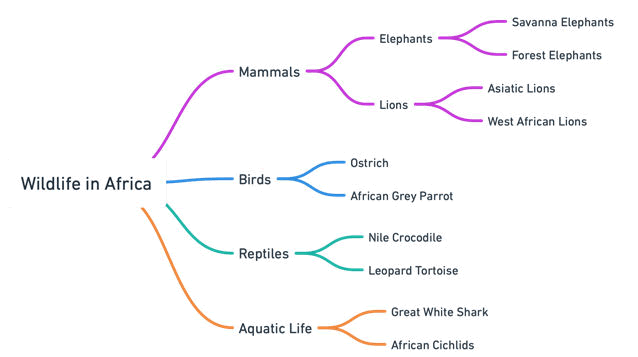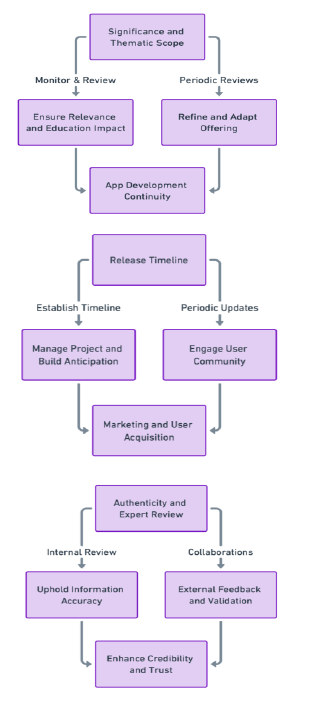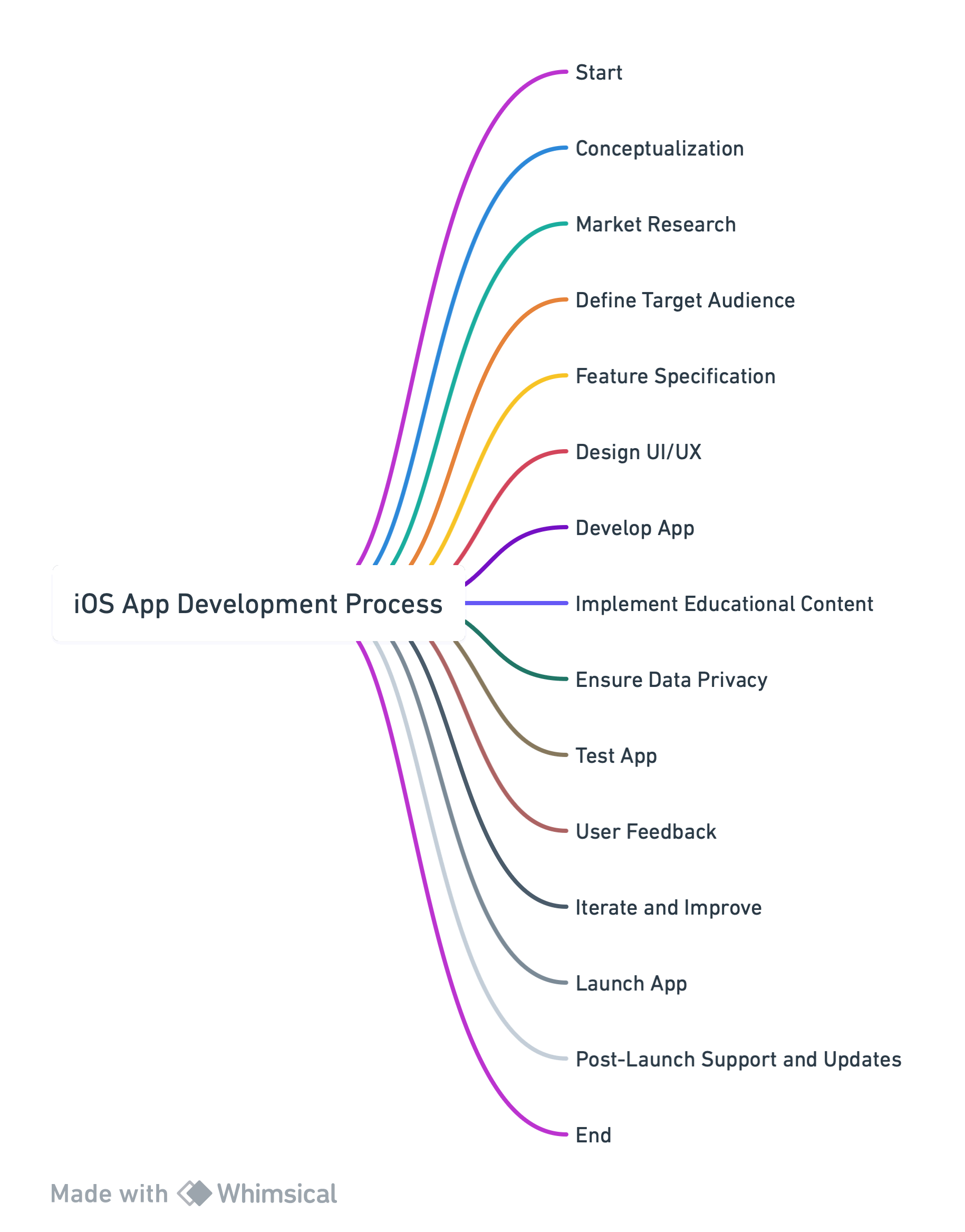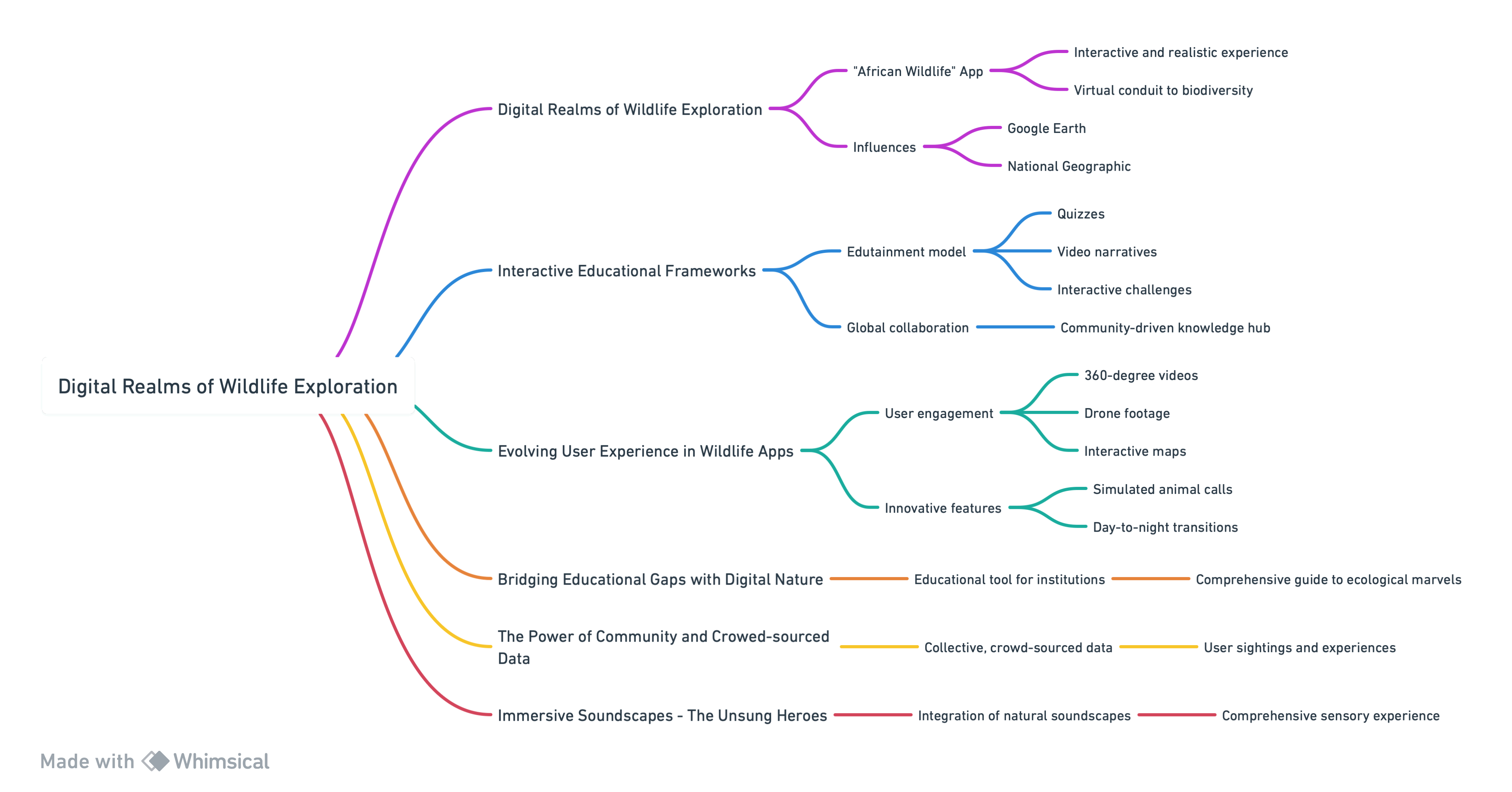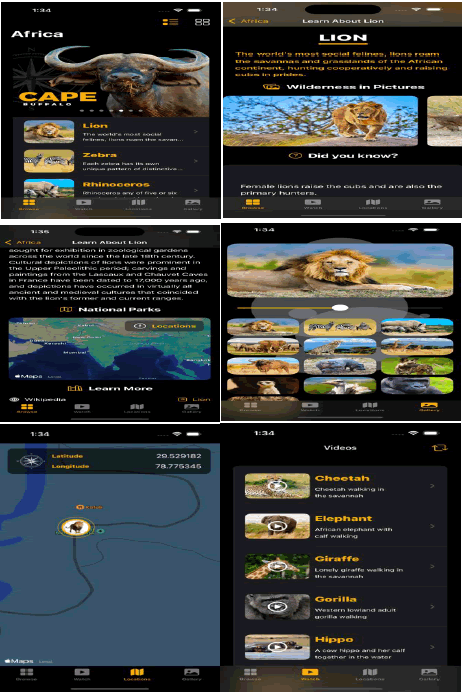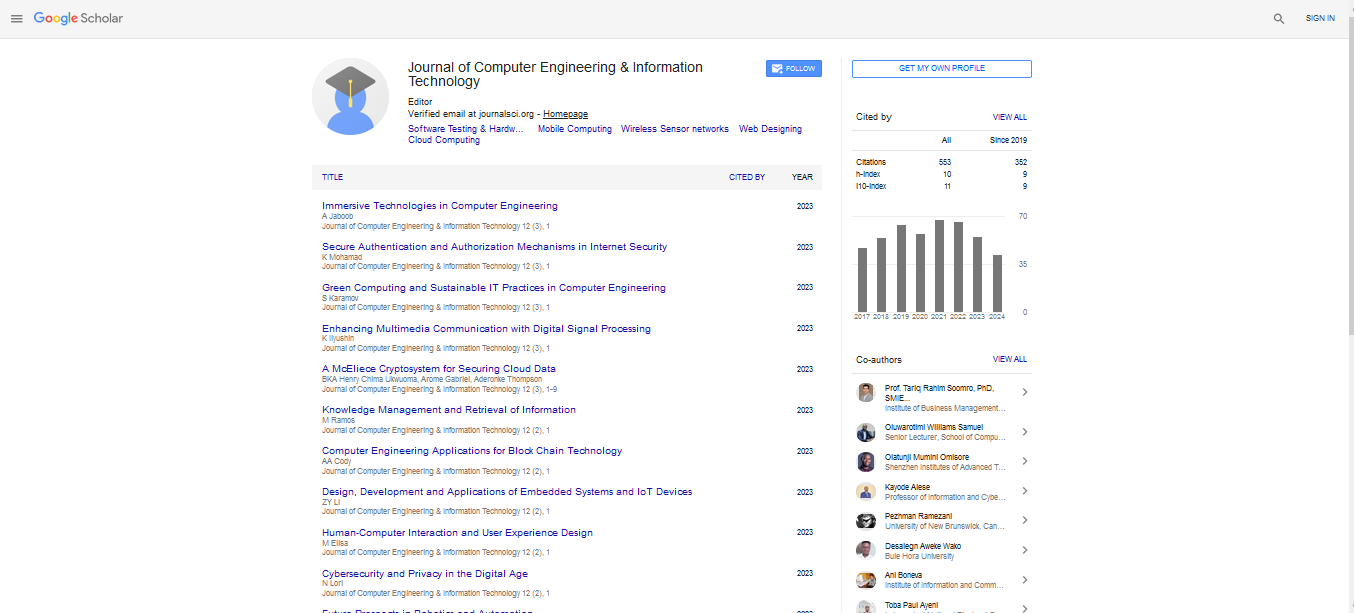Research Article, J Comput Eng Inf Technol Vol: 14 Issue: 1
Exploring African Biodiversity through Technology
Ashish Goyal*, Anubhav Goel, Loveneet Kamboj, Gurmeet Kaur, Nitin and Anjali
Department of Computer Science, Chandigarh University, Punjab, India
*Corresponding Author:Ashish Goyal
Department of Computer Science, Chandigarh University, Punjab, India
E-mail: 20BCS2478@cuchd.in
Received date: 24 November, 2023, Manuscript No. JCEIT-23-121081;
Editor assigned date: 27 November, 2023, PreQC No. JCEIT-23-121081 (PQ);
Reviewed date: 11 December, 2023, QC No. JCEIT-23-121081;
Revised date: 22 January, 2025, Manuscript No. JCEIT-23-121081 (R);
Published date: 29 January, 2025, DOI: 10.35248/2324-9307.1000327
Citation: Goyal A, Goel A, Kamboj L, Kaur G, Nitin, et al. (2025) Exploring African Biodiversity through Technology. J Comput Eng Inf Technol 14:1.
Abstract
WildSafariPulse: A digital window to Africa's biodiversity is an innovative iOS application that provides users with an immersive journey into the rich and varied ecosystems of Africa. Designed to be informative and engaging, this app offers an in-depth look at the continent’s unique flora and fauna. The app combines educational resources with interactive maps and a user-friendly interface, making it an exceptional tool for learning and exploration. It serves as a vital link for anyone interested in African biodiversity, from conservationists to curious learners, by promoting awareness and understanding of wildlife conservation.
Keywords: iOS application; African biodiversity; Virtual exploration; Wildlife Augmented reality
Introduction
The rich tapestry of African wildlife, with its vast landscapes and diverse ecosystems, has always captivated audiences globally. As technology continues to bridge the gap between the remote and the accessible, the African wildlife iOS application emerges as a vanguard in the domain of digital nature exploration. At the confluence of advanced mobile technology and nature preservation, this app presents a unique odyssey into Africa's wilderness, ensuring that the wonders of the continent are but a touch away from users worldwide [1]. This paper delves deep into the conceptualization, design, and features of the African wildlife app, offering insights. In an increasingly urbanized world, with many detached from the natural world, African wildlife stands as a testament to how technology can reconnect us to our planet's marvels. By harnessing the capabilities of the iOS platform, this application promises not just an educational tool but a holistic journey into the heart of Africa, reshaping our understanding and appreciation of its unparalleled biodiversity [2]. As we progress in the digital age, the blend of technology and nature, as embodied by African Wildlife, paves the way for a more informed and conservation-conscious society.
The imperative for immersive digital safari experiences
In an age where technology reigns supreme, the call for immersive experiences has never been more prominent. For many, the thrill of a safari remains a distant dream, often confined to documentaries or travel magazines. The African wildlife app is designed to bridge this gap. It provides a platform where users can virtually traverse the African plains, forests, and deserts, encountering the continent's majestic wildlife in their natural habitats. The immersive experience is not just about visual allure; it is about fostering a genuine connection between users and the natural world, instilling a sense of wonder and respect for the intricate ecosystems of Africa.
App design and interactive modules
The soul of any app lies in its design and interactivity. African wildlife is crafted meticulously, ensuring that users, whether they are tech-savvy teens or curious octogenarians, find it intuitive and engaging. The interactive maps serve as a guide, allowing users to pick regions of interest, be it the dense Congo rainforests or the expansive Serengeti plains. Each choice leads to a new adventure, a new set of animals, and a different narrative, ensuring the user experience is varied, enriching, and tailored to personal preferences.
Key features and educational values
While the app's visual spectacle is a draw, its heart lies in its educational content. Each creature featured is more than just a visual marvel; it's a story, a lesson in biology, ecology, and conservation. The profiles delve into intricate details–from an animal's diet to its mating rituals, from its predators to its conservation status [3]. The idea is to cultivate informed wildlife enthusiasts, individuals who not just appreciate the beauty of these creatures but also understand their significance and the challenges they face.
Data privacy and user safety
In our interconnected world, data privacy is paramount. The African wildlife app prioritizes user safety above all else. While the app offers immersive experiences, it ensures that user data, preferences, and interactions within the app are securely stored and protected. Any interactive feature, like quizzes or user-generated content, is designed with strict adherence to data protection regulations, ensuring that users can explore the app's wonders without any apprehensions.
Anticipated impact and future endeavours
Every technological creation, while addressing the present, must also look to the future. The African wildlife app, in its current form, is just the beginning. The potential for growth is immense. As the app gains popularity, there's room for integrating newer technologies, expanding the animal and habitat roster, and even collaborating with real-world conservation projects. The long-term vision is not just to be a digital safari tool but to evolve into a platform that actively contributes to and advocates for the preservation of Africa's splendid biodiversity (Figure 1).
Figure 1: This flowchart shows various features of the WildSafariPulse App.
Historical background
The journey of human engagement with African wildlife is as old as time, intricately woven into the tapestry of evolution, exploration, and technology. In ancient times, our ancestors revered these animals, painting their likenesses on cave walls and crafting tales around their habits and habitats. As exploration bloomed in the 15th and 16th centuries, tales of Africa's majestic beasts reached foreign shores, igniting intrigue and wonder.
In the late 19th and early 20th centuries, photography emerged as a transformative medium, allowing the world to visually experience the wonders of African wildlife. Magazines and documentaries, in the following decades, brought these creatures into living rooms globally. The dawn of television further amplified this, with channels like national geographic and discovery showcasing the marvels of the African continent (Figure 2).
Figure 2: Categorisation of wildlife in Africa.
However, as urbanization increased and the digital age took hold in the 21st century, a chasm began to form between modern societies and the natural world. Simultaneously, technological advancements in augmented reality, virtual reality, and app development opened new horizons for immersive experiences [4]. While numerous apps and platforms tried to bridge this gap, a need persisted for a more interactive, personalized, and comprehensive digital journey into Africa's wilderness.
This historical backdrop sets the stage for the African wildlife iOS app. Harnessing the power of modern technology, the app emerges as an amalgamation of humanity's age-old fascination with Wildlife and the capabilities of contemporary digital platforms. It's the next evolutionary step in humanity's quest to understand, appreciate, and preserve the unparalleled biodiversity of Africa, all within the palm of one's hand.
Materials and Methods
The conceptualization and roll-out of the African wildlife iOS app, an immersive digital journey into Africa's vast ecosystems, demands a rigorous, systematic approach to ensure its engagement, accuracy, and longevity. Here's an outline of the major phases and activities involved in its development:
Significance and thematic scope: At this stage, we ascertain the app's primary objectives, identifying the core experiences we aim to offer, our target demographic, and the specific knowledge gaps or misconceptions about African wildlife we intend to bridge. By routinely monitoring wildlife documentaries, conservation news, and emerging technologies in digital wildlife exploration, we ensure that African wildlife remains pertinent and ahead of its curve. Periodic reviews of the app's thematic scope and objectives allow us to continuously refine and adapt our offering, ensuring it resonates with and educates users in impactful ways.
Release timeline: For effective project management and to build anticipation among potential users, we establish a detailed timeline that encompasses pivotal events like teaser launches, beta testing, user feedback rounds, and the grand unveiling of the fully realized app. We are staunchly committed to releasing periodic updates about our progress, including new feature introductions and partnerships with wildlife experts, ensuring our user community remains engaged and informed throughout the app's evolutionary journey.
Authenticity and expert review: The credibility of the African wildlife app is paramount. The information and experiences we provide should not only captivate but also educate with impeccable accuracy. To uphold this standard, we employ a stringent internal review mechanism where content and interactive modules are vetted by wildlife experts and ethologists [5]. Beyond our in-house evaluations, we actively pursue collaborations with wildlife conservation organizations, seasoned naturalists, and educational institutions. Engaging with these external entities provides invaluable feedback, ensuring that the app is not just technically sound but also ecologically accurate and meaningful. This multifaceted approach fortifies the app's authenticity and positions it as a trusted source for wildlife enthusiasts worldwide (Figure 3).
Figure 3: Timeline for developing an iOS application.
Digital safari
Digital realms of wildlife exploration: The allure of exploring wildlife and natural ecosystems has been a perennial human interest, heightened in our increasingly digital age. While past technologies were limited to presenting static images or textual descriptions, they often fell short in evoking the raw beauty and complexity of the wild. Enter the "African Wildlife" app, crafted to transcend these boundaries. By offering an in-depth, interactive, and realistic experience of Africa's vast ecosystems, it serves as a virtual conduit to the continent's rich biodiversity. Drawing from platforms such as Google Earth and National Geographic's digital portals, the "African Wildlife" app seamlessly blends rich visual content with interactive modules. It also incorporates real-time tracking of species, providing users an experience akin to a live safari from the comforts of their home.
Interactive educational frameworks: The essence of wildlife education lies in the balance between imparting knowledge and fostering engagement. With this in mind, tools like the African wildlife app have evolved, mirroring the methodologies of platforms such as the Kahn Academy and Coursera [6]. Embracing the interactive edutainment model, the African wildlife app incorporates quizzes, video narratives, and interactive challenges, allowing users to deepen their understanding while staying engaged. Moreover, in the spirit of fostering global collaboration, users can share their experiences, insights, and photographs, creating a community-driven knowledge hub reminiscent of platforms like Wikipedia but tailored for African wildlife. Such collaborative educational ecosystems not only enhance knowledge dissemination but also cultivate a global community of wildlife enthusiasts.
Evolving user experience in wildlife apps: The dynamic of user engagement has been shifting rapidly. Where once static photos and descriptions sufficed, now the demand is for 360-degree videos, drone footage, and interactive maps. Platforms such as WWF's app and the nature conservancy's digital endeavours have paved the way. "African wildlife" stands on these giants' shoulders, optimizing user engagement through innovative features like simulated animal calls, day-to-night transitions in habitats, and even virtually guided safari tours [7].
Bridging educational gaps with digital nature: Traditional modes of wildlife education have often been restricted to textbooks or sporadic field visits. This limitation has been addressed by digital platforms that offer a more hands-on, interactive learning experience. The "African wildlife" app emerges as an extensive educational tool perfectly suited for academic institutions. It boasts a wealth of information on various species, their habitats, and even their historical migration patterns. Students and enthusiasts alike can rely on this app as a comprehensive guide to Africa's ecological marvels.
The power of community and crowed-sourced data: Communitydriven platforms have demonstrated the immense value of collective, crowd-sourced data. Evident from the success of platforms such as eBird, where bird watchers globally share their observations, the community's collective input can be invaluable. The "African wildlife" app adopts a similar approach [8]. Users can not only log their sightings but also share personal experiences or even contribute data to scientific research projects. This inclusivity ensures that the app's content remains dynamic and ever-evolving and fosters a global sense of commitment to wildlife conservation.
Immersive soundscapes-the unsung heroes: While most naturefocused apps emphasize the visual aspect, auditory experiences are equally vital in replicating the essence of an environment. Earlier applications might have overlooked this dimension, but the value of integrating natural soundscapes has been increasingly recognized. The "African wildlife" app integrates these rich ambient sounds, ranging from the subtle rustling of grass in the savannah to the distant lion roars, ensuring users receive a comprehensive sensory experience.
With these comprehensive features and insights, the "African wildlife" iOS app stands as a pioneering force in the realm of digital wildlife engagement, inviting users to embark on a detailed journey into Africa's majestic landscapes and ecosystems.
Biodiversity connection
Savannah interface algorithm: In this section, we delve deep into the algorithmic foundation that powers the African wildlife app's user interface design, called the Savannah interface algorithm [9]. This algorithm's complexity ensures a visually captivating and informative experience. Its algorithmic design covers the following essential elements:
Dynamic habitat rendering: We dissect how the app's interface algorithm renders accurate and visually engaging representations of various African habitats. Factors such as the time of day, specific regions, and seasonality are considered to craft an authentic visual journey for the user.
Interactive wildlife profiles: Here, we explore the techniques behind real-time pop-ups displaying comprehensive details about different African animals. Every tap by the user results in rich information being displayed, making the experience both entertaining and educational.
Guided safari journeys: This segment delves into the algorithmic logic behind the app's guided safari tours. Users embark on structured tours through Africa's vast landscapes, enriched with voiceovers, waypoints, and points of interest.
Adaptive regional display: This component sheds light on the app's ability to adjust its content based on specific African regions. From the Serengeti plains to the Namib Desert, the app offers customized experiences tailored to various geographical settings.
User engagement mechanics: Here, we detail the algorithms designed to boost user interaction. From quizzes about African Wildlife to challenges and feedback systems, the app ensures that users are constantly engaged and learning (Figure 4).
Figure 4: iOS app development process in XCode.
Ecosystem dynamics algorithm
Moving on, we focus on the ecosystem dynamics algorithm, the heart of the African wildlife app's ability to showcase the intricate relationships between different species and their environments. Let's dive into its comprehensive breakdown:
Basics of ecosystem dynamics: We initiate by elucidating the primary principles that underpin the realistic depiction of ecological interactions within the app.
Predator-prey simulations: This section illuminates the intricate simulations that mirror the predator-prey dynamics in African habitats, considering variables like region-specific behaviours, day-night cycles, and food availability.
Animal behaviour patterns: We delve into the algorithms that define and showcase distinctive behaviour patterns of animals, from their feeding habits to their mating dances and defensive mechanisms.
Environmental impact modelling: The app uses this algorithm to demonstrate the effects of changes in the environment on Wildlife. This could be due to seasonal shifts, climatic changes, or human intervention.
Optimized performance: Concluding, we touch upon the measures employed within the Ecosystem Dynamics Algorithm to ensure a seamless user experience, guaranteeing swift animations, rapid content loading, and fluid transitions throughout (Figure 5).
Figure 5: Application features of WildSafariPulse iOS App.
Results and Discussion
Application architecture
The African wildlife iOS app's architecture is deliberately structured to offer users an enlightening and immersive dive into the fauna of Africa. At its core, it uses a client-server model, allowing users to interact with detailed, real-time information on African wildlife [10]. The application's structure can be understood through the following segments:
Client-side components: The app presents an intuitive, visually pleasing interface on the client end. This component manages the realtime display of animal data, user interactivity, and synchronization of information with the server, such as animal counts and pictures.
Server infrastructure: Prioritizing reliability and the ability to scale, the server infrastructure is anchored in a cloud environment. It acts as the chief aggregator and disseminator for animal statistics, multimedia content, and external links, such as wikipedia pages.
Communication protocols: The African wildlife iOS app has adopted efficient communication channels that ensure seamless exchange of data between the user's device and the server. These are designed to minimize delays, delivering a consistently smooth user experience.
The architecture's scalability ensures that the app remains responsive, whether it's used by a student researching for a school project or by wildlife aficionados exploring the continent's vast biodiversity [11]. It efficiently supports an array of multimedia formats and detailed databases, welcoming users into the vibrant world of African wildlife.
Features and functionality
The African wildlife iOS app is not just another mobile application; it's an intricately designed digital conduit into the heart of Africa's biodiverse expanse. Here's a detailed breakdown of its multifaceted features:
Animal encyclopaedia
• In-depth profiles: Each animal is presented with a comprehensive profile detailing everything from its dietary habits to its role in the ecosystem. This ensures that users don’t just skim the surface but get a profound understanding of each creature.
• Search and filter options: A user-friendly search mechanism allows enthusiasts to easily find specific animals, and filters can be applied to search by habitat, dietary habits, or conservation status, among other criteria [12].
• Interactive maps: Embedded within the encyclopaedia are interactive habitat maps, enabling users to visualize the regions these animals call home.
Population counter
• Real-time updates: The app sources real-time data, ensuring that users get the most recent figures on the number of animals in the wild [13]. This data is crucial for researchers, conservationists, and wildlife enthusiasts to track the health of species populations.
• Conservation status indicator: Along with the number count, each animal profile highlights its conservation status–whether it’s endangered, vulnerable, or of least concern–making users aware of the pressing realities many of these species face.
External wikipedia link
• Extended learning: By providing a direct portal to wikipedia, the app ensures that users can seamlessly transition to a more detailed and extensive database if they wish to delve deeper into the annals of a species’ existence.
• Curated content: The app’s design ensures that the wikipedia link takes users directly to trusted and well-researched sections, filtering out potential misinformation and focusing on academic and scientifically verified content.
Visual exploration
• High-resolution imagery: The app boasts a rich gallery of high-definition photos that bring the majesty of African wildlife right to the user's screen [14]. Every image is meticulously chosen to showcase the animals in their raw, untamed splendour.
• Slideshow features: Users can indulge in a visual treat with the slideshow function, allowing them to sit back and embark on a pictorial journey across the African landscape.
• User submissions: To foster a community feel, there's a feature for users to contribute their own wildlife images (subject to review), making the app a continually growing repository of user-generated content (Figure 6).
Figure 6: Features and function of African wildlife iOS app.
In essence, the African Wildlife iOS app promises not only an informative experience but also an interactive and visually captivating journey, sensitizing users to the marvels and challenges of the African wildlife domain.
Conclusion
In the realm of wildlife applications, the WildSafariPulse iOS app presents a revolutionary experience. It ingeniously marries the awe of Africa's wildlife with advanced digital capabilities, offering users a comprehensive lens into the enchanting world of African fauna. Bolstered by features such as a dynamic animal encyclopaedia, realtime population counters, seamless wikipedia integration, and visually arresting high-resolution imagery, the app establishes itself as an indispensable tool for wildlife enthusiasts, conservationists, and educators alike.
Key takeaways
The WildSafariPulse iOS app stands out because of its depth and breadth. The detailed profiles of each animal, juxtaposed with stunning visuals, provide a holistic understanding of the African ecosystem. Its commitment to real-time data updates, while educating users about the conservation status of various species, underscores the app's dedication to promoting wildlife preservation. This is not just an app; it's a window into a world that many may never get to experience first-hand.
Challenges persist
While the African wildlife app is a commendable stride in wildlife digital platforms, challenges in the realms of data accuracy, usergenerated content moderation, and real-time updates are ever-present. These challenges underscore the importance of continuous improvements, feedback loops, and partnerships with wildlife experts to ensure the app remains an authentic, reliable source.
Evolution with technological advancements
The trajectory of the African Wildlife app is intricately tied to the evolution of technology. With the potential future integration of augmented reality, machine learning for animal behaviour prediction, and even interactive 3D models, the horizon looks promising. The app's future iterations should not only focus on being a knowledge reservoir but also on enhancing user engagement through immersive experiences. The intersection of technology and nature, as exemplified by the African wildlife app, heralds a vibrant future where learning, conservation, and innovation converge.
References
- Agha M, Batter T, Bolas EC, Collins AC, Gomes da Rocha D, et al. (2018) A review of wildlife camera trapping trends across Africa. Afr J Ecol 56: 694-701.
- Talbot LM (1965) A survey of past and present wildlife research in East Africa. Afr J Ecol 3: 61-85.
- Ashley C, Hussein K (2000) Developing methodologies for livelihood impact assessment: Experience of the African wildlife foundation in East Africa.
- Goadrich MH, Rogers MP (2011) Smart smartphone development: iOS versus Android. InProceedings of the 42nd ACM technical symposium on Computer science education, pp. 607-612.
- Abbott J, Guijt I (1997) Changing views on change: a working paper on participatory monitoring of the environment. London: IIED.
- Ashley C (1999) Financial and livelihood impacts of butterfly farming at Arabuko Sokoke forest. Kenya: AWF.
- Ashley C, Carney D (1999) Sustainable livelihoods: Lessons from early experience. London: DFID.
- Ashley C, Elliott J, Sikoyo G, Hanlon K (1999) Handbook for assessing the economic and livelihood impacts of wildlife enterprises. Kenya: AWF.
- Ashley C (2000) Applying livelihood approaches to natural resource management initiatives: Experiences in Namibia and Kenya-ODI Working Papers 134.
- Booth D, Holland J, Hentschel J, Lanjouw P, Herbert A (1998) Participation and combined methods in African poverty assessment: renewing the agenda. Social Development Division Africa Division. London: DFID.
- Brock K (1999) Implementing a sustainable livelihoods framework for policy-directed research: reflections from practice in Mali. Brighton, UK: Institute of Development Studies.
- Carney D (ed.) (1998) Sustainable rural livelihoods: What contribution can we make?. London: DFID.
- Casley D, Lury D (1981) Data collection in developing countries.
- DfID UK (1999) Sustainable livelihoods guidance sheets. London: DFID. 445: 710.
 Spanish
Spanish  Chinese
Chinese  Russian
Russian  German
German  French
French  Japanese
Japanese  Portuguese
Portuguese  Hindi
Hindi 
